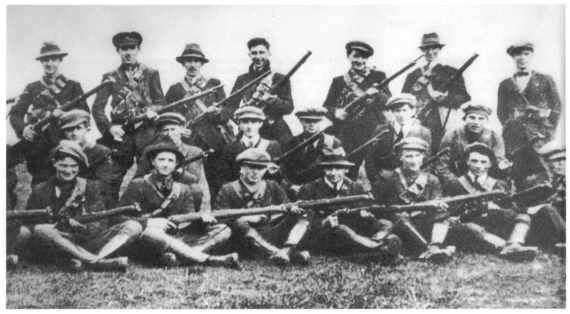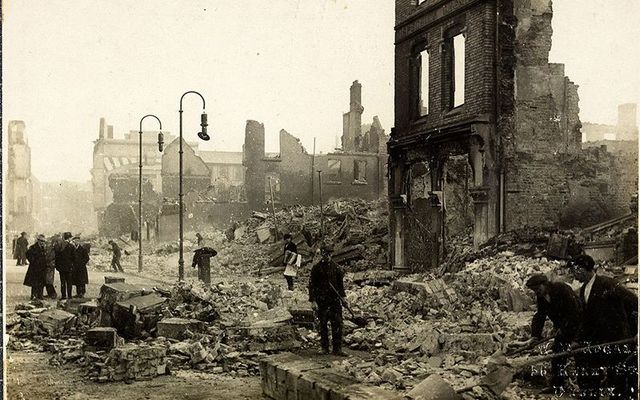Origins of Irish guerrilla tactics and how they were modified during the Irish War to be successful.
The origins of Irish guerrilla tactics used during the War of Independence (1919-1921) are difficult to determine. Many writers claimed that the type of guerrilla campaign initiated by the IRA was without precedent, and some officers insisted that their methods were unique and homegrown. However, as do all successful insurgents, the Irish Volunteers/IRA studied the tactics of previous guerrilla wars and adapted the most favorable of them to the Irish terrain and circumstances. The Irish War demonstrated how insurgents can and must modify to be successful.
The War of Independence contributed four concepts that we find in later insurgencies:
1. Irish forces could hold their own against the British only in a guerrilla war.
2. It was not necessary to wait until all conditions for making revolution exist; the insurrection can create them – Che Guevara used this later.
3. The Irish countryside was the basic area for armed fighting, but guerrilla principles worked well in Dublin – the Irish War was probably the first urban war to succeed.
4. The Irish made extensive use of roadside explosives – what are now called Improvised Explosive Devices, or IEDs.
The Irish War of Independence was the first guerrilla war in which there was a significant counterinsurgency use of mechanized vehicles. The Irish had to develop tactics, techniques and procedures to disrupt and disable the British counter-insurgency forces.
Read more: Winston Churchill ordered Black and Tans into Ireland on this day in 1920
Moreover, the primary purpose of the Irish ambush was to acquire weapons. Guevara stated the principle that ‘All attacks should recover the amount of ammunition as that expended’. When the War started in 1919, Britain became a vital source of arms for the IRA. Two things are needed for any guerrilla war, and Michael Collins took the point in providing both: arms and money. Collins did business with gunsmiths in London, German arms dealers, British members of the IRA who worked at collieries in Scotland, criminal gangs in the Mid-lands – in effect, anyone who would take their money. Liverpool Volunteer Paddy Daly recalled: ‘we found the Englishman always willing to do business’.
The British command at the Curragh Camp required that all Lorries on patrol carried a ‘box of 1000 rounds of .303 ammunition’ to supplement that carried by each soldier. (The .303 ammunition was used in British rifles as well as in Lewis and Maxim machine-guns and was the most prevalent ammunition size used by weapons in the War on both sides.) Taking a lorry’s spare ammunition was a prime motive for all Irish ambushes. In fact, at the end of the War in July 1921, it was apparent that the Irish ran out of ammunition: they didn’t run out of weapons, they were running out of ammunition.
Read more: 50,000 military records of Easter Rising and War of Independence released
The British started out using high driving speeds to avoid an ambush. In response, the Irish would dig a shallow trench in the roads to disable the British lorries. As guerrilla wars are always evolving, the Irish found that their simple answer was soon unsuccessful, so by autumn 1920, Irish ambush tactics began to change. To counter the use of armor, the IRA began to rely on interdicting the roads particularly by the use of explosives.
The Irish were not the first to use explosives in ambushes: the first recorded roadside assassination effort by explosives was an attempt on Napoleon in 1803. Irish revolutionaries used explosive devices in the mid 19th century, and by the Fenians in the latter part of the century, but mostly in attacks on barracks and other buildings, not in ambushes. Where the Volunteers/IRA were really the first was to manufacture from raw materials explosives, casings, springs, and all the other necessary bomb components.
The IRA IEDs came from 3 sources:
- Stolen from civilian companies, particularly Scottish quarries and mines
- Stolen from the British military
- Manufactured in Irish munitions factories
At the beginning of the War the most common explosive used was gelignite (a nitric based explosive) stolen from quarries, along with detonators customarily used in collieries. Gelignite was susceptible to freezing and could not be left in the ground for long periods in cold weather, and as a commercial explosive was simply not powerful enough unless used in very large quantities. The supply was insufficient and became more difficult to obtain, so the Irish turned to chemists and others with military experience from WW I to develop home-made explosives.
James O’Donovan was the primary ‘chemist/inventor’ of explosives for the IRA, and the person most responsible for developing and establishing Irish-centered explosive manufacturing. He was a post-graduate chemistry student at UCD and worked directly for Collins.
He began producing fulminate of mercury explosives in 1918 – a notoriously unstable compound. In 1919 Collins directed O’Donovan to develop an explosive that was more powerful, but that ‘men with no technical skill could produce it in a farmhouse kitchen… They have to be fairly foolproof because we can’t have people all over the country having their heads blown off!’

Leader Michael Collins.
Irish War Flour was O’Donovan’s first original explosive, named after its appearance: it was a nitrated resin using the ingredients of resin, flour, acid and potassium chlorate. Irish War Flour was quite unstable and didn’t have the explosive power he wanted so he kept experimenting.
He called his second explosive compound Irish Cheddar, again named because of its looks. This was his nickname for a form of cheddite, an explosive used quite extensively in the early 20th century. Its ingredients were paraffin, potassium chlorate, nitrobenzene and castor oil.
The first attempt at a road mine in the War took place at Annascaul on 18 August 1920. The IRA command detonated a small charge in the roadway, a lorry was upset, the British surrendered and the Irish took their weapons. The attack at Annascaul utilized a very small mine and was the first used against a vehicle, but an IED was not the norm in ambushes at that time.
In autumn 1920 and thereafter, there was an increase in IRA anti-road and anti-bridge attacks, and they also began to use what we now call IEDs in ambushes with regularity. In the British War Diaries, there were reports of 172 ambushes from then until the Truce in July 1921, and 109 used explosive devices of some sort. The British records of their use are the most accurate, and they indicate that of the 109 attempts there were about 23 instances when the bombs did not cause much damage.
British tactics taught at the Curragh noted ‘Lorries should be so disposed in depth that it becomes difficult for the ambushers, without employing a large force, to ambush the whole column’. The IRA quickly learned the trick of laying multiple roadside IEDs at the same spacing as the British vehicles in a convoy, which usually traveled 300 yards apart.
Having the explosives was not enough – proper placement of IEDs was difficult for the inexperienced Irish – they had little enough training in how to conduct ambushes and placement of men, much less how to use explosives in these attacks. As the War progressed, the Irish found that their IEDs were best initiated not by pressure/contact detonators, but with electrical detonators attached to hidden wires buried in the road and exploded just when they were crossed by a lorry or armored car.

Irish Volunteers / IRA men.
The first major IRA attack with what we would now recognise as an IED with sufficient explosive power to bring the fight to a quick result was on 2 February 1921 in the Clonfin ambush in County Longford. Under the command of Sean MacEoin, the IRA attacked two lorries of Auxiliaries, disabled one, killed four (including the O/C Lieutenant Commander Francis Craven) and wounded nine, and after a short firefight the Auxiliaries surrendered. Following the fight, the Irish recovered twenty rifles and over 1200 rounds of .303 ammunition.
The IRA eventually had 11 foundries making bomb components by the Truce in July 1921. Collins also had his engineers working on armor-piercing ammunition, because his sources could not buy them at any price. However, the Irish were never able to manufacture their own.
The IRA’s use of explosives did not stop with the end of the War of Independence. During the Civil War, on 18 August 1922, a fuel delivery lorry was packed with explosives and set off in Dundalk. The anti-Treaty IRA had set off the bomb to stop the Free State army who were marching on Dundalk barracks, which had been taken over by anti-Treaty forces under Frank Aiken on 14 August.
Though Collins wanted to utilize IEDs as much as possible, he knew their primitive explosives were unreliable and the Irish were inexperienced in their use. As a result there were few ambushes where the IEDs were crucial, rather than ancillary, to the attack itself. However, the Irish War of Independence introduced the IED and the car bomb to the catalogue of guerrilla war tactics.
Sidebar on James O’Donovan (Séamus Ó Donnabháin)
James O’Donovan became IRA Director of Chemicals in 1921.
Apart from devising most of the explosives in the War of Independence, O’Donovan has an ‘interesting’ story. He was arrested during the War of Independence, imprisoned in Mountjoy Prison and Kilmainham Gaol. He went anti-Treaty and imprisoned during the Civil War.
In August 1938, at the request of Sean Russell, he wrote the ‘S-Plan’ a bombing and sabotage campaign targeting England. In his unpublished memoirs O’Donovan wrote that he ‘conducted the entire training of cadre units, was responsible for all but locally-derived intelligence, carried out small pieces of research and, in general, controlled the whole explosives and munitions end’ of S-Plan.
O’Donovan went to Germany in 1939 and became a spy for the Abwehr. Ernst Weber-Drohl, an Abwehr agent, was landed by submarine in County Sligo in February 1940, and reported to O’Donovan as his contact. The Germans requested O’Donovan concentrate his S-Plan attacks on military rather than civilian targets.
Increases in the security surrounding infrastructure targets in Britain had a major effect on the IRA’s ability to conduct operations, and their attacks tapered off around early to mid-1940. At the time, O’Donovan noted the S-plan was: ‘hastily conceived … with ill-equipped and inadequately-trained personnel, too few men and too little money....and fizzled out like a damp and inglorious squib’. In the 1960’s, O’Donovan assessed the results: ‘It brought nothing but harm to Ireland and the IRA’.
James O’Donovan died in Dublin on 4 June 1979.
Read more: True scale and violence of Ireland War of Independence as seen from Kerry
* Originally published in April 2018 issue of An Cosantóir (The Defender) The Irish Defence Forces Magazine."Joseph Connell is the author of Dublin in Rebellion: A Directory 1913 – 1923.




Comments